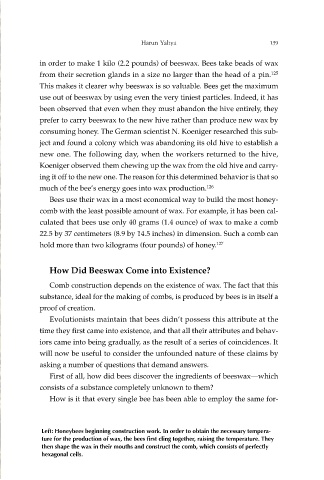Page 141 - The Miracle of the Honeybee
P. 141
Harun Yahya 139
in order to make 1 kilo (2.2 pounds) of beeswax. Bees take beads of wax
from their secretion glands in a size no larger than the head of a pin. 125
This makes it clearer why beeswax is so valuable. Bees get the maximum
use out of beeswax by using even the very tiniest particles. Indeed, it has
been observed that even when they must abandon the hive entirely, they
prefer to carry beeswax to the new hive rather than produce new wax by
consuming honey. The German scientist N. Koeniger researched this sub-
ject and found a colony which was abandoning its old hive to establish a
new one. The following day, when the workers returned to the hive,
Koeniger observed them chewing up the wax from the old hive and carry-
ing it off to the new one. The reason for this determined behavior is that so
much of the bee’s energy goes into wax production. 126
Bees use their wax in a most economical way to build the most honey-
comb with the least possible amount of wax. For example, it has been cal-
culated that bees use only 40 grams (1.4 ounce) of wax to make a comb
22.5 by 37 centimeters (8.9 by 14.5 inches) in dimension. Such a comb can
hold more than two kilograms (four pounds) of honey. 127
How Did Beeswax Come into Existence?
Comb construction depends on the existence of wax. The fact that this
substance, ideal for the making of combs, is produced by bees is in itself a
proof of creation.
Evolutionists maintain that bees didn’t possess this attribute at the
time they first came into existence, and that all their attributes and behav-
iors came into being gradually, as the result of a series of coincidences. It
will now be useful to consider the unfounded nature of these claims by
asking a number of questions that demand answers.
First of all, how did bees discover the ingredients of beeswax—which
consists of a substance completely unknown to them?
How is it that every single bee has been able to employ the same for-
Left: Honeybees beginning construction work. In order to obtain the necessary tempera-
ture for the production of wax, the bees first cling together, raising the temperature. They
then shape the wax in their mouths and construct the comb, which consists of perfectly
hexagonal cells.

